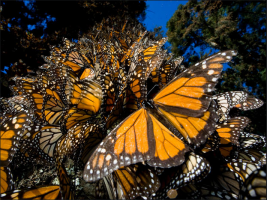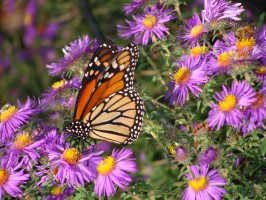By Marcia Myers
Monarch butterflies are in serious decline, so raising and releasing them must be good, right? It would seem so, but some experts have concerns.
On October 8, “a group of 10 monarch researchers and conservationists from across the U.S. issued a statement highlighting concerns with the release of commercially raised and other mass-reared monarch butterflies and recommended against the practice.”
Some companies sell monarch butterflies for release at weddings or other special events and promote the mass releases as beneficial:
- Surely, adding any monarchs to the environment helps.
- Some breeders guarantee their butterflies are “disease-free” or “healthy”.
- State that research has not proven mass releases are harmful.
Some scientists and conservationists are concerned about:
- Disease spreading
- Inhibited studies of wild populations from mass releases
- Survival rates of released captive monarchs
- Inbreeding
- Captivity adaptations
- Not enough research
Whether it is for commercial gain, special event and hobby enjoyment, classroom education, conservation, pollination, and/or biological diversity, a lot of interested parties want to save the monarch butterflies. And with an estimated 90% already gone, time is running out.
According to Elizabeth Howard, Founder and Director, Journey North, the chance to raise and tag a monarch is an experience many remember for a lifetime, and a powerful tool for fostering a commitment to monarch conservation.
She recommends:
- Do not purchase monarchs (adults, eggs or larvae) from a mass-breeder for release into the wild.
- Only raise and release as many monarchs as you need for educational purposes (~ 1 per student).
- Only rear one generation to prevent disease from building.
- Follow these rearing guidelines from the Monarch Joint Venture to keep rearing conditions safe and clean.
- Educate others by communicating this important conservation message in your community and throughout your networks.
- Remember: The only way to accomplish monarch recovery is to protect the habitat they need.




I was unaware that breeders are doing this! Now I know.
Instead, I have planted a native garden w/Monarch-friendly plants. Can’t wait till spring to see results.
Thanks.
That’s awesome. I hope you share the results.
I had someone tell me they ordered Monarch butterflies to release at a wedding. I thought they were confused on the type of butterfly. I guess they were correct.
I enjoy raising the monarch caterpillars inside plastic jars in my kitchen. I raised 20 this summer. I left some caterpillars out on the plants in my yard. Only one of them survived. All of the ones I brought inside survived. I have 5 types of milkweed in my yard. The common milkweed (Asclepias syriaca) is the only plant that my Monarchs used to deposit their eggs. I wonder why?
Marcia, thanks for this article.
You’re welcome Kathy. Do you know about the Monarch Larva Monitoring Project? They would probably love to have your information. It’s a citizen science project.